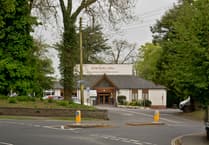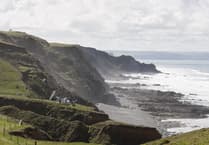By Ray Roberts, photographer
I WENT for a walk down the lane near Pounda that runs past Haye Farm, over a ford and up to Trehunist. Although this narrow track is commonly known as Haye Lane, there was so much vegetation on the hedges that it might easily be named Green Lane with so many harts tongue and male ferns everywhere.
Our postman told me that some years ago the lane was used as a short-cut between Trehunist and Haye Farm but now the tarmac has been over-grown and, in some places, there are deep trenches carved out by running water making it unusable even for tractors.
After crossing the ford which, when the level of water in the stream is low, means walking over a concrete bridge. When the stream is deep, water runs over the concrete creating a ford. I started walking up the steep hill and noticed several red campions were still out in bloom. These flowers – Silene dioica – can be seen virtually all year round in the parish and they certainly brighten up a dark hedgerow.
I also spotted a few barren strawberry – Potentilla sterilis – flowers on the south facing hedge. These white blooms have gaps between their five petals that show green sepals, unlike the wild (sweet) strawberry – Fragaria vesca – that has petals that almost touch and, of course, produce those small sweet berries of delight.
The leaves of cow parsley – Anthriscus sylvestris – have been evident on the hedgerows for some time now and in the lane, there were a couple of plants already out in bloom with many umbels of tiny white flowers on hollow stems that turn brown when completely ripe. This is one of the earliest umbelliferae plants to flower, along with its larger cousin, the hogweed.
Near the top of the lane were several large clumps of navelwort – Umbilicus rupestris – leaves. Sometimes known as pennywort the leaves on long stalks, are disc shaped with a depressed centre and are a very familiar sight on hedges and high banks around Cornwall. In fact they don’t always need very much soil to grow on and are often seen on old stone walls.
After I had walked through Trehunist on the last leg of my journey, a rainbow suddenly appeared across the fields. This sight celebrated the shower I walked through whilst in Haye Lane and I will mention this about these seven coloured bands in the sky: when you see a rainbow and would like to photograph it, do it as soon as you can because a rainbow is like the afore mentioned bullfinch – they don’t hang around for long.
A don’t know if school children learn the little rhyme that helps me remember the rainbows colours. I learnt it whilst in the Primary class in Landrake School – ‘Richard Of York Gained Battles In Vain.’ That reminds you; Red, Orange, Yellow, Green, Blue, Indigo, Violet.




